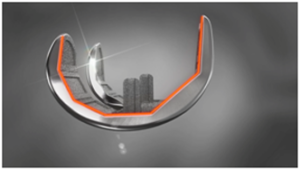The value of bone preservation
Bone preservation is an important factor to consider in knee replacement as the removal of too much bone can limit a patient’s future treatment options. and take away their native condylar shape and joint line, which may lead to patient dissatisfaction post-operatively.
Removing large amounts of bone stock is often thought of as necessary to make the patient’s bone fit the implant during the procedure. Standard off-the-shelf sizing isn’t optimized for bone preservation and as a result excess bone is taken in order to make the patient fit a pre-determined component size.
This can cause multiple problems. First, the removal of too much bone can limit a patient’s future treatment options. The success rate for a revision knee procedure is substantially lower than that of a primary TKA, with one key factor being the amount of bone stock available.1
Second, removing large amounts of bone can result in the loss of the patient’s native condylar shape and joint line, which may lead to patient dissatisfaction post-operatively.
Building bone preservation into implant design
An analysis of 89 first-generation iTotal®CR patients (106 knees), including 15 simultaneous bilateral replacements, across four centers saw zero cases requiring blood transfusions.2
 In another study comparing one surgeon’s iTotal®CR cases with a standard off-the-shelf TKA, zero of 54 patients (66 knees) required blood transfusions. Four patients from the off-the-shelf arm (60 patients, 66 knees) required transfusions.3
In another study comparing one surgeon’s iTotal®CR cases with a standard off-the-shelf TKA, zero of 54 patients (66 knees) required blood transfusions. Four patients from the off-the-shelf arm (60 patients, 66 knees) required transfusions.3
A unique design feature of the Conformis customized TKA is a six-chamfer cut design. This allows for a thinner implant, which translates directly into bone preservation without sacrificing implant strength (Figure 1).
A recent study looking at clinical outcomes compared bone preservation in two groups of total knee replacement patients: one using an off-the-shelf system (Zimmer® NexGen®) and the other using a customized total knee implant with patient-specific instruments (Conformis iTotal®CR).

The average of all bone resection measurements for the customized knee was 27% (14mm) less than for the off-the-shelf knee (Table 1). The study also found that on average, the total thickness of the customized implants was 25% less than the off-the-shelf implants.2
1: Schnurr, et al; How much tibial resection is required in total knee arthroplasty? International Orthopaedics (SICOT); 2011, 35: 989-994
2: Kurtz, William; Patient-Specific Knee Replacement Implants Preserve Bone and Decrease Blood Loss & Swelling. BASK Annual Meeting 2013, Poster #0138

